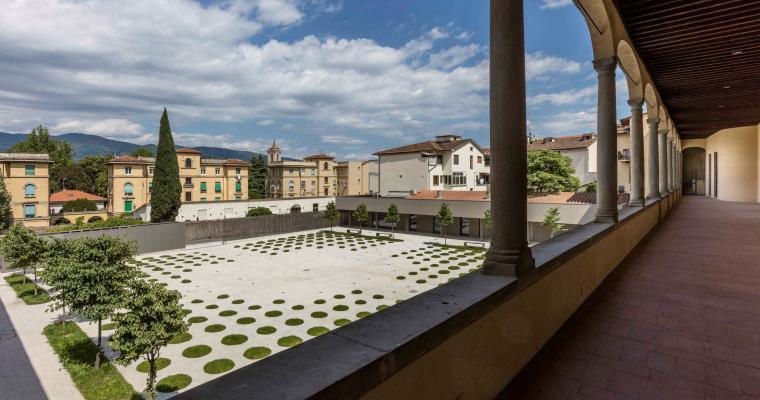Small, easy to get around and less crowded than the most famous Tuscan destinations, Pistoia is a quiet and welcoming city of art: the ideal destination for slow tourism away from mass tourist itineraries. Walking through the characteristic streets and crossing the squares you will discover ancient palaces, museums, churches and treasure chests of art and history.

Palazzo Fabroni in Pistoia
Pistoia preserves many hidden treasures. For lovers of contemporary art, a visit to Palazzo Fabroni is a must. The museum of contemporary art is located in via Sant’Andrea 18, in the historic center – right next to the Romanesque church of Sant’Andrea with the splendid pulpit by Giovanni Pisano (1301) – where you can admire a wonderful collection of works and installations. The palace, which bears the name of the Pistoia family who lived there until 1842, is today one of the centers of greatest dissemination of contemporary art in the city. The museum itinerary starts from the ground floor where an informative video-installation on the history of the building informs visitors about the collections up to the new garden. Here is also located the section dedicated to Pistoia artists of the 20th century from the second half of the ‘20s to the end of the ‘60s. On the first floor the visitor will be welcomed by the imposing Shadow Sculpture by Claudio Parmiggiani on the walls, after which the path continues with the monographic rooms dedicated to the Pistoia Mario Nigro, Fernando Melani, Gualtiero Nativi and Agenore Fabbri and eleven photographic portraits of artists by Aurelio Amendola are distributed in various rooms. The second floor is dedicated to temporary exhibitions and hosts, from time to time, several artists representing interesting currents of contemporary visual arts. A tour inside Palazzo Fabroni will be useful to deepen the knowledge of the personalities who, in the 20th century, have renewed the artistic language specializing in visual arts.

Historic Rolling Stock depot of Pistoia
The Historic Rolling Stock depot of Pistoia has reopened its doors to the general public, as an open-air museum of steam engines and historic trains in maintenance and with tourist routes on board historic trains. It is a place of other times, born to keep alive the memory of a centuries-old tradition, the steam locomotive one. The Pistoia depot, born in 1851, is one of the oldest and most prestigious sites for the shelter and maintenance of historic trains: it is the most important in Italy and it’s absolutely competitive with the few similar structures existing and active in Europe. After running the risk of being dismantled, today the Pistoia depot consists of two remittances for locomotives, one dating back to 1864 with three tracks and the other, with six tracks, built in 1927. At the center of the clearing between the two buildings are the locomotives on display, located on the tracks around the circular turntable and exhibits a total of about forty vehicles. Entered into operation in 1864 parallel to the opening of the Porrettana railway line, the Depot has seen, in over 150 years of life, the passage and evolution of numerous locomotives. From the steam ones, up to the diesel and electric ones, which were maintained in efficiency. By visiting the Depot, it will be possible to see documents that testify to the evolution of rail transport in Italy through the industries operating in the sector: Ernesto Breda and Officine Ansaldo, Fiat and OM, the times when Italy was at the forefront in the transport sector. The restoration of the building completed in recent years has brought to light new medieval traces that give the place an air that smells of ancient but in step with the times. A mix of old and contemporary that makes it majestic and unparalleled. Visitors and fans of vintage rolling stock will be able to admire unique pieces and real rarities up close. An open-air museum where the historic trains land and leave to travel along railway sections that risked being forgotten. Today, however, they have been recovered for tourist purposes and it is therefore possible to travel the Porrettana route on a fascinating historic train.

Pinocchio Park in Collodi
Pinocchio, the Talking Cricket, the Blue Fairy and all the characters of “The Adventures of Pinocchio”, the result of the imagination of the Florentine writer Carlo Lorenzini, aka Carlo Collodi, come to life in a park known throughout Italy, the Pinocchio Park in Collodi, in the province of Pistoia. The park dedicated to the famous puppet is a large completely outdoor space, which for years has fascinated young and old who at least once in their lives want to visit the park to delve into the magical world of the fairy tale. Walking inside, surrounded by well-kept vegetation, we gradually find the main protagonists of the story. Pinocchio, the Fairy, the Cat and the Fox and many other characters, allow visitors to retrace some of the most significant episodes of the fairy tale. The Pinocchio Park is an enchanted place, with an almost retro atmosphere. Adults walk among bronze sculptures and works by artists who have worked for the park from 1956, the year the garden opened, to today; while the little ones will be amazed by the whale that in the park becomes a fountain with jets of water, enchanted houses where you can see the Blue Fairy and magical chess with which to play. A jump into the magic of this park – where the charm of Pinocchio’s fairy tale continues to live thanks to the memory in our hearts, memories and imagination of all children, but also of adults – is an enchanted experience that you will hardly forget.

Terme di Montecatini
Montecatini Terme is the city of Liberty, nature and water. The territory is dotted with countless parks and green spaces while the most beautiful Art Nouveau architecture are undoubtedly the spas. An experience not to be missed if you are in Pistoia and want to explore its surroundings. In fact, Montecatini Terme has recently become the 56th Italian site on the UNESCO World Heritage List. The thermal baths of Montecatini boast a centuries-old history. Its thermal waters were already appreciated by the Romans, the first urban settlements around the central area of the spa are due to the Grand Duke of Tuscany Pietro Leopoldo, who also gave the order to build the baths from 1773 to 1783. And then a wide avenue lined with elms was also built, which later became one of the symbols of the city. At the beginning of the 20th century, Montecatini began the transformation from a city of baths to a spa town, also thanks to the work of the architect Giulio Bernardini, who on the example of other spa towns in Switzerland, Bohemia and Germany, built some emblematic buildings such as the Terme Tamerici, the Terme Excelsior and the Public Park. The complex of Terme Tettuccio is great. Considered the symbol of the city and its glorious past, the Tettuccio, in addition to being the most famous establishment of the Spa, is a real ensemble of beauty so as to take the name of “temple of European thermalism”. The grandeur of the travertine building, inspired by the buildings of the Roman baths, and the richness of the decorations that characterize the interiors, represent the maximum expression of the thermal architecture of Montecatini. A place that tourists and visitors can not help but photograph so much is its beauty.

Abetone e Montagna Pistoiese
Abetone, in the province of Pistoia, is a mountain town located at 1388 meters above sea level, and it’s famous for being a destination for winter holidays for skiing but also summer thanks to the products of the forest that are found there and the splendid itineraries that attract trekking lovers from all over Italy. The Apennines area consists of about 50 kilometers of slopes for alpine skiing, with 22 ski lifts and 18 kilometers of slopes for Nordic skiing. Winter sports enthusiasts will find paradise here. The soft white snow, the surrounding nature, the Tuscan cuisine are excellent ingredients for a wonderful winter holiday. In Abetone and in general in the Pistoia Mountains, wonderful views await you, dotted with excellent shelters that offer every kind of relaxation. The perfect place for those who love nature, sport, active holidays but do not want to give up good food and taste typical dishes of Tuscany. La Selletta, baita del Pulicchio, rifugio Ovovia and rifugio del Monte Gomito offer a bar, restaurant and self-service. Places where you can spend relaxing days even for those who are not lovers of skiing, many facilities offer terraces with sun loungers in which to lie down and enjoy the sun at high altitude. In summer, visitors and tourists will find delightful green landscapes, fruit trees, mushrooms and the delicious products of the forest such as strawberries, blueberries and raspberries. An ideal place to spend a holiday in the cool away from the chaos and heat of the big cities.








